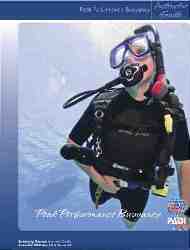 |
| From the Training Bulletin |
PADI's Peak Performance Buoyancy course is PADI's second most popular specialty after Enriched Air. The recently-updated materials incorporate advances in technology (such as the the unique buoyancy control demands of technical diving / CCRs) - as well as cosmetic changes.
Teaching Tips for Peak Performance Buoyancy
Use the new PPB Instructor outline (part no. 70236 rev. 2011) to offer three buoyancy training options:
- a buoyancy clinic in the pool
- an adventure dive
- the two-dive specialty course.
Begin by dialing in the student's weight at the surface. The student should float at eye level while holding a normal breath and having an empty, or near-empty BC. Be sure to have a variety of weights nearby to make adjustments. It's important to repeat this exercise at the end of the dive when the student has 750-500 psi.
The next step is to have the diver fine-tune weighting by positioning and distributing weights for different applications, for example:
- A wall dive: head-up, feet-down position (weights placed towards the middle of the back).
- Taking photos: slightly head-down, feet-up position (position weights towards the chest away from the hips and/or adjust tank position tank higher or lower in the BCD).
- Using a CCR: rebreathers should be at minimal loop volume and the top of the diver’s head should float level with the surface.
Suspend the hula hoop in the water using the rope and weights and have divers swim through it. Or, suspend a plastic toy in the water and have divers hover next to it / take photos of it. Challenge divers to throw the toypedo around without touching the bottom (while hovering or swimming).
Don't forget to repeat the buoyancy check at the surface (described above) at the end of your confined water session.
We recently published a PPB teaching tips article in the Surface Interval e-newsletter. Read the complete Surface Interval article. Additional game and skill practice ideas are included in the new instructor guide (product no. 70236 version 2.0 from 2011)
Did You Know...?
You can integrate the PPB specialty into the Open Water course. It requires some additional skills and one extra dive.* See page 33 of the 2011 PADI Instructor manual for details. Please note, you may only integrate one specialty course with Open Water.
 |
| 2011 instructor manual page 33 |
* There is a limit of three training dives per day. You can only add the PPB dive if the student completed (at least) OW dives one and two on the previous day.










